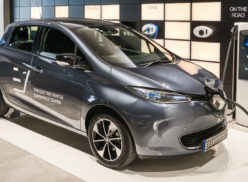By Courtney Ehrlichman
This post originally appeared in the Electrification Coalition blog.
Where we can make an impact
At Panasonic Smart Mobility Office (SMO), we are applying our expertise to tackling the climate crisis in the most impactful way possible. As the largest source of greenhouse gas emissions, the transportation sector was a clear priority, and we are focusing on the market segment that will drive out inefficiencies in the market and reduce emissions quickly: fleet electrification.
Fleets have higher vehicle miles traveled than passenger vehicles, offering the greatest emissions reduction potential per vehicle over individual owners. They also have a much bigger impact on emissions reductions, for example, medium- and heavy-duty (MHD) trucks comprise only 10% of vehicles on the road but contribute 29% of the sector’s total greenhouse gas emissions. Fleets are also at the front edge of driving scale in the battery vehicle markets while serving as early test cases for tackling the charging and grid connection complexities that will one day be faced for mass scale of electrification.
Our focus on fleets also stems from the convergence of market forces accelerating the electrification transition. The historic levels of investment being made by the federal government are set to accelerate the EV market 20% faster than previously forecasted by 2030, according to BloombergNEF. In the transit industry, states like California and cities including Chicago, New York, and Seattle have set goals of electrifying their fleets. Leading companies comprising a combined $1 trillion in revenue are planning to purchase over 330,000 electric fleet vehicles over the next four years. The United States recently joined a non-binding memorandum of understanding that sets a goal for 30% zero-emission MHD vehicle sales by 2030 and 100% by 2040.
The challenges ahead
With these bold plans and increased federal and state investment, the transportation sector is ready to get to work. On the other side of the charger, utilities are faced with new demand and increased volatility as fleets start to plug in and run on electricity.
Utilities must build out the grid to ensure it is robust enough to hold up during hours of the highest demand for electricity. When designing a new charging depot for an electrified fleet, fleet operators and utilities alike are often in sticker shock after seeing the cost of the required wires, transformers, and generators to support the energy needs of the fleet. The majority of the cost is due to the fact that the charging depot is capable of demanding a massive amount of power all at once. The problem is exacerbated when multiple charging depots end up clustered in a localized area of the grid as well.
Utilities often utilize demand charges, a monthly charge that is based on the maximum usage of electricity over a small time period, to financially discourage an electric customer from putting too much demand on the grid all at once. These chargesare often major monthly operational costs and can undermine the cost benefits of electrification. Transit fleets are especially vulnerable to demand charges, given the size and high utilization of their fleets.
The opportunities to unlock
Fleet charging could potentially be one of the smartest and most flexible loads on the grid in the near future, which unlocks tremendous opportunities for savings for both the fleet operators and utilities. With smart charge management, charging schedules can be optimized so that fleets avoid costly demand charges, and utilities can ensure that the reliability of their grid is not impacted by massive demands for electricity from clusters of fleets charging.
Smart charge management can also help reduce up-front utility upgrade costs and delays. Through data-driven modeling of efficient charge management practices that guide distribution planning efforts by utilities, managed charging can allow for existing capacity to be used more intelligently. When utilities can avoid additional infrastructure upgrades and are able to sell more energy through existing infrastructure, electric rates can actually decrease, providing financial benefit to all customers, especially those in lower income brackets.
It is precisely this balancing act, finding and maintaining the equilibrium point between the needs of the grid and those of the fleet operators, where we have set out to build our solution: Panasonic Efleet Solutions of America (PEFSA). Leveraging our decades of experience developing automotive components and battery solutions for electric vehicles, Panasonic SMO has been partnering with electric vehicle OEMs, fleets operators, EV charging providers, and utilities to pilot our smart charge management software solution that ties together each piece of a growingly complex charging system.
PEFSA unlocks new, shared value between utilities and fleets by addressing these questions from both sides of the meter, dynamically managing the demand for electricity while also enabling fleet charge scheduling, providing insights into vehicle health and status, and serving as an interoperable and EVSE provider agnostic solution. By implementing PEFSA, fleets and utilities can electrify with confidence that the needs and opportunities for both sides can be met.
In the coming months, we look forward to partnering with more leaders in this space to tackle the intricacies of fleet charge management and unlocking the full potential of electric vehicles for fleets and beyond.
Courtney Ehrlichman is the Head of Strategy with Panasonic Smart Mobility Office.







